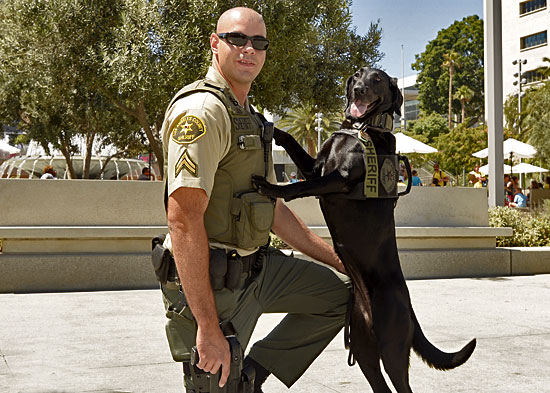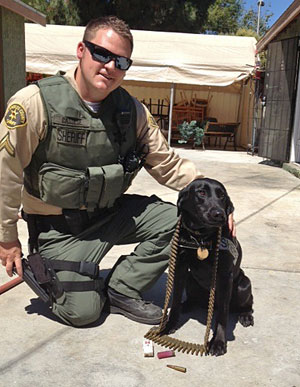The dogs of war come home
August 8, 2013

She was a hero overseas and now Tula, along with handler Dep. Guillermo Loza, is making L.A. County safer.
Just last year, Tula was in Afghanistan, sniffing out buried explosives and saving lives and limbs in the war zone. Now her beat is Los Angeles County, where on a recent afternoon she put her exceptional sniffing abilities to work on a random stroller she encountered in Grand Park.
The glossy black Labrador retriever has traded in her military handler for a new partner on the homefront, Los Angeles County Sheriff’s Deputy Guillermo Loza.
Tula and Loza are part of Countywide Services Division K9, a new sheriff’s unit that started operating last month with a mission of keeping watch over county facilities, parks and events. Tula is an explosives dog, trained to find the various bomb materials that could be used in an attack. She and another black Lab, Ruby, joined the department after serving with the U.S. Marines in Afghanistan. There, Tula and Ruby were experts in locating roadside bombs known as IEDs, or improvised explosive devices. IEDs are the leading cause of fatalities for the U.S. and its allies, responsible for the deaths of 3,275 soldiers in Afghanistan and Iraq as of Memorial Day, 2013.
“They uncovered more than 40 IEDs each,” said Sergeant Mark Jennings, who heads the new division, which also includes his narcotics-sniffing dog, Chip. “They can’t give me a number of lives these dogs saved, but with convoys, it’s in the hundreds.”
Jennings, a former Marine, scored the sought-after hero dogs for Los Angeles County last fall in North Carolina, where representatives from dozens of law enforcement agencies vied for 50 of the returning military canines. The program is part of a campaign to place the dogs as the U.S. reduces its canine military strength in Iraq and Afghanistan from 480 dogs to 180.
As Tula and Ruby went through their paces in front of the law enforcement crowd, Jennings was impressed—and he wasn’t alone.
“Just about everyone wanted Tula and the other half wanted Ruby,” he said. “We had to do a drawing, and we got lucky.”
The 3-year-old Tula and the muscular 6’4” Loza made a striking duo as they made the rounds in Grand Park recently.
“I like your dog,” shouted a young girl while skipping toward the park’s splash fountain.
“Aww, what’s her name?” asked a woman dressed in business attire, while a tourist snapped a photo.
They’re getting used to attention from the public.
“At first they see this tall deputy and they’re like ‘oh my God’ but then they relax and say, ‘Oh look, there’s a dog here,’ ” Loza said.
On cue, Tula darted off and investigated bushes, trash cans, bags and anywhere else a bomb might be hidden. Finding nothing, she returned for a bit of affection and a chance to play with her favorite chew toy.
Like other veterans, Tula and Ruby returned with a few psychological scars.
“Initially they wanted to be very close to you,” Jennings said. “As far as noises and being around people, they were a little hesitant, a little jumpy. They definitely showed signs of what I call PTSD in dogs.”
Handlers of explosive-sniffing dogs need to be the best of the best too, Jennings said. The wrong handler “can screw up a dog very easily.” Loza and Deputy Danny Cassese, who handles Ruby, were at the top of their training class—a prestigious distinction.
Before being deployed, the dogs and deputies trained together with a local expert for four weeks. As they make the transition from military to civilian duty, it helps that they are Labradors, a popular pet breed. The dogs are mellow and gregarious in crowds. German shepherds, on the other hand, tend to intimidate people, Cassese said.
The biggest hurdle was training Tula and Ruby to work on leashes. In Afghanistan, all their searching was performed “off-leash.” Handlers would send them ahead to scout for explosives. On their new beat, much work must be done “on-leash.”
Yet the ability to work off-leash is what sets Tula and Ruby apart from the dogs assigned to the 60 other K9 units in the county, which search for bombs and also things like narcotics, guns and dead bodies. Working off-leash allows the former war dogs to explore suspicious situations while human deputies keep a safe distance.
The dogs live with the deputies and the pairs develop a close bond, which is essential to their performance. Continued training is part of the job description and up to 3 hours of each shift is devoted to it. When the day is done, Tula and Ruby live the good life of any other well-cared-for pet in Southern California. Tula likes running on the beach and investigating every corner of Loza’s house, while the 5-year-old Ruby “will play with a tennis ball until she passes out,” Cassese said.
The deputies receive daily training on trends in terrorism and counter-terrorism efforts, said Loza, who believes domestic attacks like the Boston Marathon bombing could increase as U.S. war efforts draw to a close and create a greater focus on stateside targets. That’s where Tula and Ruby come in.
Last week, the dogs “cleared” (declared safe) a suspicious package at Los Angeles City College. Their biggest find so far came on a parole compliance sweep, which is one of their secondary duties, performed on request. Because guns and ammunition contain gunpowder, the dogs can detect it. Ruby located a belt of 75 high-caliber rifle rounds meant for a machine gun, 50 smaller rifle rounds and a 12-gauge shotgun round that were in the possession of a prior felon. (Loza said both dogs found the bullets, but Ruby got the credit “this time.”)
Jennings said the program is a great financial deal for the county. Bomb-sniffing dogs are bred specifically for the task and undergo months of expert training. All told, each would normally cost upwards of $50,000. As more return from the war, Jennings hopes to expand the division to include up to 5 more K9 teams.
Not all returning war dogs are deemed young enough and fit enough for further service. Some have had serious injuries.
Bob Agnor, a senior trainer for K2 Solutions, a company that provides the dogs and training to the military, said those dogs are returned to civilian life, often being adopted by their Marine handlers.
“These dogs literally saved their lives,” said Agnor, whose company hosted the North Carolina event at which Tula and Ruby were recruited. “They think, ‘This dog has earned the right to live in my house and be treated like a king or a queen.’ ”
Tula and Ruby still wear military dog tags in honor of their service abroad. When they retire from the Sheriff’s Department, Loza and Cassese will have the first option to adopt.
“I’ll get to keep Tula,” said Loza, smiling broadly. “And I will, of course. She’s the best partner ever.”
Posted 8/1/13














 405 bridge work causes a stink
405 bridge work causes a stink
